Deck 11: How Genes Are Controlled
Question
Question
Question
Question
Question
Question
Question
Question
Question
Question
Question
Question
Question
Question
Question
Question
Question
Question
Question
Question
Question
Question
Question
Question
Question
Question
Question
Question
Question
Question
Question
Question
Question
Question
Question
Question
Question
Question
Question
Question
Question

Unlock Deck
Sign up to unlock the cards in this deck!
Unlock Deck
Unlock Deck
1/41
Play
Full screen (f)
Deck 11: How Genes Are Controlled
1
Bacterial RNA polymerase binds to the ______.
A) operator
B) proto-oncogene
C) regulatory gene
D) promoter
A) operator
B) proto-oncogene
C) regulatory gene
D) promoter
D
2
What is the first level of control of eukaryotic gene transcription?
A) RNA splicing
B) attachment of RNA polymerase to the promoter
C) DNA packing and unpacking
D) the binding and unbinding of transcription factors to enhancer sequences
A) RNA splicing
B) attachment of RNA polymerase to the promoter
C) DNA packing and unpacking
D) the binding and unbinding of transcription factors to enhancer sequences
C
3
Which of these is most likely to cause the development of a six-legged frog?
A) mutation of homeotic genes
B) artificial selection
C) dietary supplementation
D) conversion of a proto-oncogene to an oncogene
A) mutation of homeotic genes
B) artificial selection
C) dietary supplementation
D) conversion of a proto-oncogene to an oncogene
A
4
Which of the following turns off transcription by binding to the operator?
A) RNA polymerase
B) repressor
C) promoter
D) lactose
A) RNA polymerase
B) repressor
C) promoter
D) lactose

Unlock Deck
Unlock for access to all 41 flashcards in this deck.
Unlock Deck
k this deck
5
Introns are ______.
A) noncoding DNA sequences
B) DNA sequences to which activators bind
C) expressed DNA sequences
D) the product of RNA splicing
A) noncoding DNA sequences
B) DNA sequences to which activators bind
C) expressed DNA sequences
D) the product of RNA splicing

Unlock Deck
Unlock for access to all 41 flashcards in this deck.
Unlock Deck
k this deck
6
Repressors act by blocking the binding of _____ to the operator.
A) promoters
B) DNA polymerase
C) the operon
D) RNA polymerase
A) promoters
B) DNA polymerase
C) the operon
D) RNA polymerase

Unlock Deck
Unlock for access to all 41 flashcards in this deck.
Unlock Deck
k this deck
7
Which of these is a type of post-transcriptional regulation of gene expression?
A) inactivation of tRNA
B) alteration of DNA nucleotide sequences
C) alteration of proteins
D) binding of transcription factors to enhancers
A) inactivation of tRNA
B) alteration of DNA nucleotide sequences
C) alteration of proteins
D) binding of transcription factors to enhancers

Unlock Deck
Unlock for access to all 41 flashcards in this deck.
Unlock Deck
k this deck
8
In bacteria,what name is given to a cluster of genes with related functions,along with their DNA control sequences?
A) operon
B) activator
C) promoter
D) exon
A) operon
B) activator
C) promoter
D) exon

Unlock Deck
Unlock for access to all 41 flashcards in this deck.
Unlock Deck
k this deck
9
Male tortoiseshell cats ______.
A) do not have an X chromosome
B) have orange and black patches of fur that reflect the pattern of X chromosome inactivation
C) are usually XYY individuals
D) are likely to be exceedingly rare and very likely to be sterile since normal male cats are XY
A) do not have an X chromosome
B) have orange and black patches of fur that reflect the pattern of X chromosome inactivation
C) are usually XYY individuals
D) are likely to be exceedingly rare and very likely to be sterile since normal male cats are XY

Unlock Deck
Unlock for access to all 41 flashcards in this deck.
Unlock Deck
k this deck
10
In eukaryotic cells,repressor proteins inhibit transcription by binding to ______.
A) silencers
B) enhancers
C) regulators
D) operators
A) silencers
B) enhancers
C) regulators
D) operators

Unlock Deck
Unlock for access to all 41 flashcards in this deck.
Unlock Deck
k this deck
11
In prokaryotes,the production of a single RNA transcript for a group of related genes is under the control of the ______.
A) operon
B) master control gene
C) signal transduction pathway
D) homeobox
A) operon
B) master control gene
C) signal transduction pathway
D) homeobox

Unlock Deck
Unlock for access to all 41 flashcards in this deck.
Unlock Deck
k this deck
12
Cells communicate with one another via ______.
A) cascades of gene activation
B) the diffusion of RNA transcripts through adhesion junctions
C) signal transduction pathways
D) RNA splicing
A) cascades of gene activation
B) the diffusion of RNA transcripts through adhesion junctions
C) signal transduction pathways
D) RNA splicing

Unlock Deck
Unlock for access to all 41 flashcards in this deck.
Unlock Deck
k this deck
13
Which of these plays a role in the regulation of transcription in both prokaryotic and eukaryotic cells?
A) RNA splicing
B) attachment of RNA polymerase to the promoter
C) transcription factors
D) gene operons
A) RNA splicing
B) attachment of RNA polymerase to the promoter
C) transcription factors
D) gene operons

Unlock Deck
Unlock for access to all 41 flashcards in this deck.
Unlock Deck
k this deck
14
What would you assume if you found RNA transcripts of lactose-utilizing genes within E.coli?
A) the binding of lactose to the lac operon activator
B) the presence of lactose
C) the presence of lac operon activator protein
D) the absence of lac operon repressor protein
A) the binding of lactose to the lac operon activator
B) the presence of lactose
C) the presence of lac operon activator protein
D) the absence of lac operon repressor protein

Unlock Deck
Unlock for access to all 41 flashcards in this deck.
Unlock Deck
k this deck
15
How can a single RNA transcript be translated into different polypeptides?
A) There is more than one way to splice an RNA transcript.
B) There is more than one way to modify the coded polypeptide.
C) The length of its tail can vary.
D) Two different genes can produce the same RNA transcript, which will then be translated differently.
A) There is more than one way to splice an RNA transcript.
B) There is more than one way to modify the coded polypeptide.
C) The length of its tail can vary.
D) Two different genes can produce the same RNA transcript, which will then be translated differently.

Unlock Deck
Unlock for access to all 41 flashcards in this deck.
Unlock Deck
k this deck
16
At one point,you were just an undifferentiated,single cell.You are now made of many cells; some of these cells function as liver cells,some as muscle cells,some as red blood cells,while others play different roles.What name is given to the process that is responsible for this?
A) gene expression
B) regeneration
C) carcinogenesis
D) cellular differentiation
A) gene expression
B) regeneration
C) carcinogenesis
D) cellular differentiation

Unlock Deck
Unlock for access to all 41 flashcards in this deck.
Unlock Deck
k this deck
17
The "master control genes" that regulate other genes,which determine what body parts will develop in which locations,are called ______.
A) enhancers
B) homeotic genes
C) oncogenes
D) operons
A) enhancers
B) homeotic genes
C) oncogenes
D) operons

Unlock Deck
Unlock for access to all 41 flashcards in this deck.
Unlock Deck
k this deck
18
The process by which genotype becomes expressed as phenotype is ______.
A) phenogenesis
B) transcription
C) gene expression
D) recombination
A) phenogenesis
B) transcription
C) gene expression
D) recombination

Unlock Deck
Unlock for access to all 41 flashcards in this deck.
Unlock Deck
k this deck
19
While examining a human cell that functions normally,you determine that it has 45 functional chromosomes and one chromosome that is almost completely inactive. You immediately decide that it is very likely that this cell ______.
A) came from a normal human female
B) is lacking a chromosome
C) is a gamete
D) will become cancerous if one or two more genes are mutated
A) came from a normal human female
B) is lacking a chromosome
C) is a gamete
D) will become cancerous if one or two more genes are mutated

Unlock Deck
Unlock for access to all 41 flashcards in this deck.
Unlock Deck
k this deck
20
In an operon,the ______ acts as an on/off switch.
A) operator
B) promoter
C) activator
D) repressor
A) operator
B) promoter
C) activator
D) repressor

Unlock Deck
Unlock for access to all 41 flashcards in this deck.
Unlock Deck
k this deck
21
Homeotic genes ______.
A) have very different sequences in plant cells as compared to animal cells
B) are an example of convergent evolution
C) are evidence of the common ancestry of eukaryotic organisms
D) regulate gene expression in both prokaryotic and eukaryotic cells
A) have very different sequences in plant cells as compared to animal cells
B) are an example of convergent evolution
C) are evidence of the common ancestry of eukaryotic organisms
D) regulate gene expression in both prokaryotic and eukaryotic cells

Unlock Deck
Unlock for access to all 41 flashcards in this deck.
Unlock Deck
k this deck
22
What name is given to a gene that causes cancer?
A) pathogene
B) cancogene
C) homeotic gene
D) oncogene
A) pathogene
B) cancogene
C) homeotic gene
D) oncogene

Unlock Deck
Unlock for access to all 41 flashcards in this deck.
Unlock Deck
k this deck
23
What is a difference between embryonic and adult stem cells?
A) The use of embryonic stem cells raises fewer ethical issues than the use of adult stem cells.
B) Embryonic stem cells are undifferentiated; adult stem cells are partially differentiated.
C) It is easier to enucleate embryonic stem cells.
D) Adult stem cells are easier to grow in culture.
A) The use of embryonic stem cells raises fewer ethical issues than the use of adult stem cells.
B) Embryonic stem cells are undifferentiated; adult stem cells are partially differentiated.
C) It is easier to enucleate embryonic stem cells.
D) Adult stem cells are easier to grow in culture.

Unlock Deck
Unlock for access to all 41 flashcards in this deck.
Unlock Deck
k this deck
24
Many proto-oncogenes regulate ______.
A) cell growth
B) cell suicide
C) cell division
D) cell repair
A) cell growth
B) cell suicide
C) cell division
D) cell repair

Unlock Deck
Unlock for access to all 41 flashcards in this deck.
Unlock Deck
k this deck
25
How is it that the cells in different body tissues are able to perform different functions?
A) The cells exhibit different patterns of gene expression.
B) Different chromosomes have been inactivated in different cells.
C) The cells contain different genes.
D) The mutations that have accumulated in the cells of the different tissues control functions.
A) The cells exhibit different patterns of gene expression.
B) Different chromosomes have been inactivated in different cells.
C) The cells contain different genes.
D) The mutations that have accumulated in the cells of the different tissues control functions.

Unlock Deck
Unlock for access to all 41 flashcards in this deck.
Unlock Deck
k this deck
26
Inheritance of certain genes increases the risk of getting certain cancers; thus,it can be said that ______.
A) these cancers are inherited as a dominant trait
B) mutations that occur in somatic cells can be passed from parent to offspring
C) predisposition to these cancers is inherited
D) (for these individuals) lifestyle will have little impact on cancer risk
A) these cancers are inherited as a dominant trait
B) mutations that occur in somatic cells can be passed from parent to offspring
C) predisposition to these cancers is inherited
D) (for these individuals) lifestyle will have little impact on cancer risk

Unlock Deck
Unlock for access to all 41 flashcards in this deck.
Unlock Deck
k this deck
27
Reproductive cloning involves
A) reacquire the genes it lost during the course of development
B) come from an early stage of embryonic development
C) be dedifferentiated
D) be implanted in the egg of an organism that is capable of regenerating lost body parts
A) reacquire the genes it lost during the course of development
B) come from an early stage of embryonic development
C) be dedifferentiated
D) be implanted in the egg of an organism that is capable of regenerating lost body parts

Unlock Deck
Unlock for access to all 41 flashcards in this deck.
Unlock Deck
k this deck
28
Consider the following figure,which outlines cloning by nuclear transplantation.Why does the clone not resemble the surrogate mother? 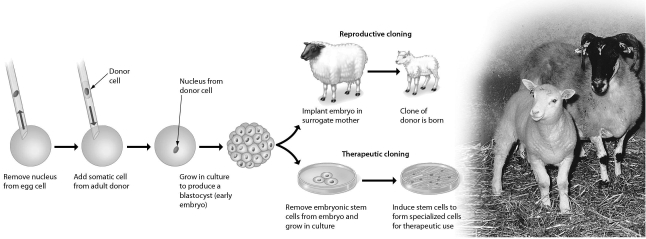
A) The sperm came from a male donor, who would also pass some of his traits to the clone.
B) The embryonic cells are adversely influenced by the surrogate.
C) The clone would exhibit characteristics of the genetic donor, not the surrogate.
D) The nuclear material from the egg would influence the appearance of the clone.

A) The sperm came from a male donor, who would also pass some of his traits to the clone.
B) The embryonic cells are adversely influenced by the surrogate.
C) The clone would exhibit characteristics of the genetic donor, not the surrogate.
D) The nuclear material from the egg would influence the appearance of the clone.

Unlock Deck
Unlock for access to all 41 flashcards in this deck.
Unlock Deck
k this deck
29
The lac operon is shown in the accompanying figure.Answer the following question after reviewing the figure.The lac operon is usually in the ______ position and is activated by ______. 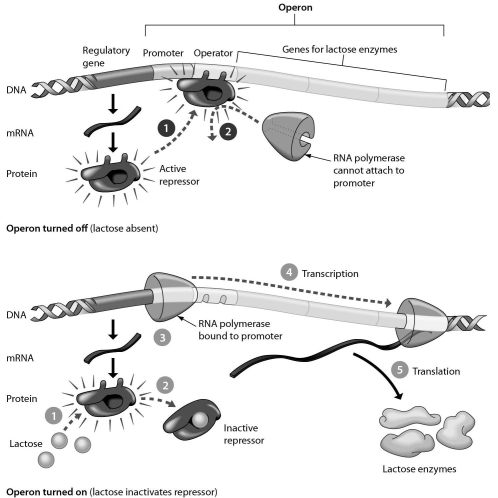
A) on... the repressor
B) off... lactose
C) of... the repressor
D) on... the promoter

A) on... the repressor
B) off... lactose
C) of... the repressor
D) on... the promoter

Unlock Deck
Unlock for access to all 41 flashcards in this deck.
Unlock Deck
k this deck
30
Data suggest that the normal version of BRCA1 functions as a(n)______.
A) oncogene
B) tumor-suppressor gene
C) proto-oncogene
D) silencer
A) oncogene
B) tumor-suppressor gene
C) proto-oncogene
D) silencer

Unlock Deck
Unlock for access to all 41 flashcards in this deck.
Unlock Deck
k this deck
31
Possible uses of reproductive cloning include ______.
A) the production of genetically identical animals for experimentation
B) the production of organs in pigs for transplant into humans
C) restocking populations of endangered animals
D) all of the above.
A) the production of genetically identical animals for experimentation
B) the production of organs in pigs for transplant into humans
C) restocking populations of endangered animals
D) all of the above.

Unlock Deck
Unlock for access to all 41 flashcards in this deck.
Unlock Deck
k this deck
32
Which risk factors are associated with cancer of the colon and rectum?
A) tobacco
B) viruses
C) UV radiation
D) dietary fat
A) tobacco
B) viruses
C) UV radiation
D) dietary fat

Unlock Deck
Unlock for access to all 41 flashcards in this deck.
Unlock Deck
k this deck
33
Examine the figure below.In a typical colon cancer,the first step is ______. 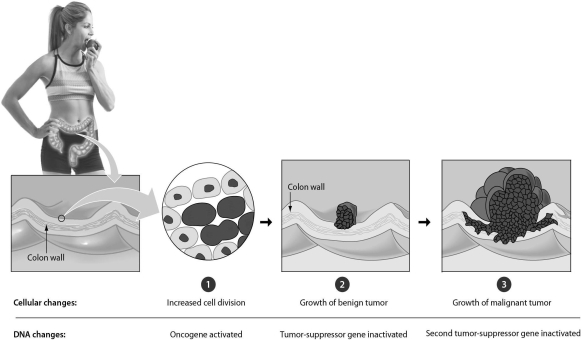
A) the inactivation of a tumor-suppressor gene
B) the mutation of a tumor-suppressor gene, producing an oncogene
C) the mutation of a proto-oncogene, producing an oncogene
D) the conversion of an oncogene to a tumor-suppressor gene

A) the inactivation of a tumor-suppressor gene
B) the mutation of a tumor-suppressor gene, producing an oncogene
C) the mutation of a proto-oncogene, producing an oncogene
D) the conversion of an oncogene to a tumor-suppressor gene

Unlock Deck
Unlock for access to all 41 flashcards in this deck.
Unlock Deck
k this deck
34
Examine the figure below.The initiation of transcription requires that enhancers bind to _____. 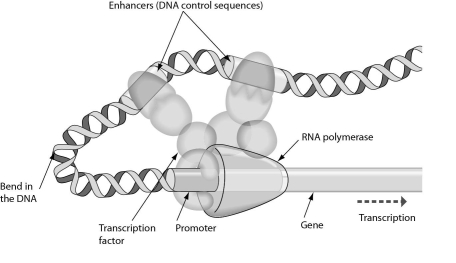
A) DNA
B) the promoter
C) transcription factors
D) RNA polymerase

A) DNA
B) the promoter
C) transcription factors
D) RNA polymerase

Unlock Deck
Unlock for access to all 41 flashcards in this deck.
Unlock Deck
k this deck
35
______ is(are)responsible for more cancers than any other carcinogen.
A) Asbestos
B) UV radiation
C) Tobacco
D) X-rays
A) Asbestos
B) UV radiation
C) Tobacco
D) X-rays

Unlock Deck
Unlock for access to all 41 flashcards in this deck.
Unlock Deck
k this deck
36
Please read the paragraph below to answer the following question(s).
Jim has become particularly interested in the genetic basis of cancer and has spent considerable time reading published papers about oncogenes. He learned that as early as 1972 researchers suggested that mutations in proto-oncogenes caused by carcinogens can convert them to oncogenes. He asked you to answer a couple of questions about this because he did not have the biology background to totally understand.
Jim learned that some cancer cells produce more growth-stimulating proteins than others.What would you give him as a plausible explanation?
A) Tumor suppresor genes may have been activated in these cells.
B) Proto-oncogenes may have mutated to become oncogenes in these cells.
C) Mutations in homeotic genes may be responsible.
D) This may result from vitamin C and vitamin E deficiencies.
Jim has become particularly interested in the genetic basis of cancer and has spent considerable time reading published papers about oncogenes. He learned that as early as 1972 researchers suggested that mutations in proto-oncogenes caused by carcinogens can convert them to oncogenes. He asked you to answer a couple of questions about this because he did not have the biology background to totally understand.
Jim learned that some cancer cells produce more growth-stimulating proteins than others.What would you give him as a plausible explanation?
A) Tumor suppresor genes may have been activated in these cells.
B) Proto-oncogenes may have mutated to become oncogenes in these cells.
C) Mutations in homeotic genes may be responsible.
D) This may result from vitamin C and vitamin E deficiencies.

Unlock Deck
Unlock for access to all 41 flashcards in this deck.
Unlock Deck
k this deck
37
Which of these techniques could tell you how gene expression differs between individuals with and without cystic fibrosis?
A) therapeutic cloning
B) DNA microarray
C) reproductive cloning
D) karyotyping
A) therapeutic cloning
B) DNA microarray
C) reproductive cloning
D) karyotyping

Unlock Deck
Unlock for access to all 41 flashcards in this deck.
Unlock Deck
k this deck
38
The figure below illustrates ______. 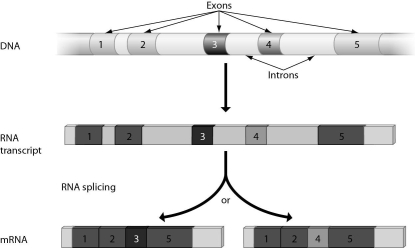
A) transcription factors
B) activators
C) alternative RNA splicing
D) protein activation

A) transcription factors
B) activators
C) alternative RNA splicing
D) protein activation

Unlock Deck
Unlock for access to all 41 flashcards in this deck.
Unlock Deck
k this deck
39
Which of these lifestyle choices will increase cancer risk?
A) jogging
B) spending more time in the sun
C) a diet low in plant fiber
D) quitting smoking
A) jogging
B) spending more time in the sun
C) a diet low in plant fiber
D) quitting smoking

Unlock Deck
Unlock for access to all 41 flashcards in this deck.
Unlock Deck
k this deck
40
More people die of ______ cancer than of any other cancer.
A) lung
B) skin
C) pancreatic
D) breast
A) lung
B) skin
C) pancreatic
D) breast

Unlock Deck
Unlock for access to all 41 flashcards in this deck.
Unlock Deck
k this deck
41
Please read the paragraph below to answer the following question(s).
Jim has become particularly interested in the genetic basis of cancer and has spent considerable time reading published papers about oncogenes. He learned that as early as 1972 researchers suggested that mutations in proto-oncogenes caused by carcinogens can convert them to oncogenes. He asked you to answer a couple of questions about this because he did not have the biology background to totally understand.
Jim learned that viruses can sometimes cause cancer and wants to know why.You tell him that ______.
A) a human cell can acquire a tumor-suppressor gene from a virus
B) a human cell can acquire a proto-oncogene from a virus
C) a human cell can acquire an oncogene from a virus.
D) some viruses are passed from mother to child and cause "inherited" cancers
Jim has become particularly interested in the genetic basis of cancer and has spent considerable time reading published papers about oncogenes. He learned that as early as 1972 researchers suggested that mutations in proto-oncogenes caused by carcinogens can convert them to oncogenes. He asked you to answer a couple of questions about this because he did not have the biology background to totally understand.
Jim learned that viruses can sometimes cause cancer and wants to know why.You tell him that ______.
A) a human cell can acquire a tumor-suppressor gene from a virus
B) a human cell can acquire a proto-oncogene from a virus
C) a human cell can acquire an oncogene from a virus.
D) some viruses are passed from mother to child and cause "inherited" cancers

Unlock Deck
Unlock for access to all 41 flashcards in this deck.
Unlock Deck
k this deck



